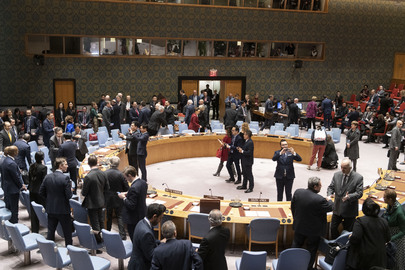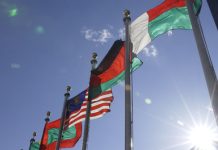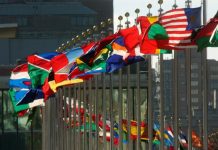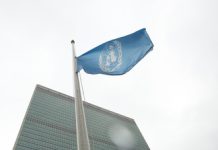As COP16 wraps up its global biodiversity meeting in Colombia this week, we are taking you to a frontline in the battle against climate change, where for centuries the Wayúu have navigated challenges in one the world’s most inhospitable environments.
When traditional knowledge meets agrobiodiversity, a term for adopting farming practices that conserve and enrich nature while contributing to long-term resilience and food security, a key ally is emerging: a unique variety of cowpea, the kapeshuna bean, or better known as the Guajiro bean.
“The Guajiro bean is tough like the Wayúu people,” said Manuel Montiel, from Ipasharrain village in the middle of La Guajira, Colombia. “It actually gets stronger when you step on it.”
Manuel Montiel of the Wayúu community in Ipasharrain village, Colombia, said the hardy Guajiro bean takes only 45 to 50 days to grow.
Ancestral star ingredient
Home to more than 600,000 people, La Guajira is the Wayúu’s ancestral homeland, stretching nearly 21,000 square kilometres across dry forests and desert dunes through the continent’s northernmost tip bordering Colombia and Venezuela. It’s also a place where food is hard to grow amid drought, floods, relentless sun, strong winds, scarce rainfall, few water sources and year-round temperatures fluttering between 35 and 40°C.
Striding through a verdant field in Ipasharrain, Mr. Montiel boldly stepped on the stringy green, brown and purple plants, stopping to carefully pick a handful of beans he then gave to his sister, wife and daughter, who with other women prepare dishes featuring the versatile pulse as the star ingredient.
As a snack, main course or appetizer, the Guajiro satisfies. Sharing recipes while cooking in Ipasharrain’s communal kitchen, Ana Griselda Gonzalez said the bean can be eaten many ways, including raw or in dishes like shapulana, a hearty soup made with goat fat and yellow corn, or, her personal favourite, cooked in the pod and paired with goat cheese.
“It fed my ancestors, and even when the situation was dire, the Guajiro bean was our main source of food,” she said, referring to the catastrophic effects of climate change that struck the region.
In Ipasharrain village in Colombia, Ana Griselda Gonzalez explains how the Guajiro bean can be roasted and eaten like a snack.
Centuries-old food security shattered
Two decades ago, climate change shattered centuries-old food security for the Wayúu as predictable rhythms of rainy and dry seasons ground to a halt with the arrival of El Niño and El Niña and other climatic factors fuelled by changing temperatures.
A devastating drought ravaged La Guajira between 2012 and 2016, eroding the livelihoods of over 900,000 inhabitants, including roughly 450,000 Wayúu people. Malnutrition, disease and child mortality spread, agriculture withered and native seeds were lost. A staggering 60 per cent of livestock perished, breaking the backbone of the Wayúu economy.
“Twenty years ago, when we knew when the rains were coming, we would save food for our animals and it would last us until the next winter,” Mr. Montiel said. “But now, animals in other communities are dying because the plants start to wither early, and the rain doesn’t come when it’s supposed to.”
An aerial view of cropland in Ipasharrain village, Colombia, supported by the UN food and agriculture agency (FAO) and partners.
From deserts to oases
Now, communities like Ipaharrain are turning patches of desert into oases, with support from the UN Food and Agriculture Organization (FAO) and partners. In addition, the Wayúu’s resilient traditional practices and techniques are also being recorded to share with nations keen on combatting climate change, through a joint project with the UN Development Programme (UNDP), known by its acronym SCALA.
So far, the results are delicious and plentiful. Ipaharrain has dedicated half an acre exclusively to food production, a leafy haven sustained through clean energy-powered pumps and drip irrigation, drawing water from a revitalised underground well.
Other such oases are sprouting up as FAO technicians work with more than 50 communities, adapting climate-smart agricultural practices to cultural and social contexts while recognising and incorporating Indigenous Peoples’s ancestral knowledge, consumption patterns and historical production traditions.
Traditional knowledge meets innovation
With a view to enhancing the Wayúu’s resilience to increasingly extreme climatic conditions, efforts are finding resilient solutions to climate-related challenges, according to Jorge Gutiérrez, the SCALA programme coordinator for FAO in Colombia.
Traditional practices are now meeting fresh innovations through a trial-and-error process that has reaped bountiful results, from soil management to sustainable food production.
Recognising the Wayúu’s dependence on rainfall has led to helping optimise existing wells and creating reservoirs to enable micro-drip irrigation. Traditional goat herders now use animal manure mixed with minerals, ashes and hydro-retainers to enrich soil and provide essential nutrients for crops and local seeds.
An UN cooking technician works with a Wayúu community in La Guajira, Colombia, demonstrating how to prepare new recipes with the new ingredients they are now able to grow.
Agrobiodiversity in action
These results demonstrate the power of agrobiodiversity in action, FAO’s Mr. Gutiérrez explained.
At the same time, some Wayúu communities have added such newly introduced crops as basil, eggplant and tomatoes to their traditional gardens of beans, corn, squash and watermelon, the kind of diversification that enhances food security, providing a buffer against climate shocks and empowering the Wayúu to improve their nutrition and economic wellbeing.
“We’re reviving traditional knowledge about the land through local seeds that are also resilient,” he said. “This community-seed dialogue ensures that children in this territory, who have unfortunately experienced significant challenges in recent years, will see improvements in their nutritional and food conditions.”
The new adaptive practices have even led to some communities having a surplus of Guajiro beans to sell or trade, Mr. Gutiérrez said, adding that ongoing UN-supported efforts aim to combat hunger and leave behind a patchwork legacy of food oases across La Guajira.
“When FAO is no longer here, we’ll be confident that they have the entire cycle – nutrients, seeds, seedbeds, nurseries and water management over time – woven into their daily lives,” Mr. Gutiérrez said.
Manuel Montiel mixes some natural fertilizer made from goat manure in Ipasharrain village, Colombia.
‘Food all year long’
Back in Ipasharrain village, Ms. Gonzalez shared a parting word before tucking into her bean dish.
“We are grateful to have all this food available now,” she said. “Before, we had to wait for rain to be able to sow or just to drink some water. Now, we have a well and food all year long.”
Ms. Gonzalez and her community have also taken a critical leap forward in building resilience in the ongoing fight against climate change.
Read an in depth version of the story here.
Source of original article: United Nations (news.un.org). Photo credit: UN. The content of this article does not necessarily reflect the views or opinion of Global Diaspora News (www.globaldiasporanews.com).
To submit your press release: (https://www.globaldiasporanews.com/pr).
To advertise on Global Diaspora News: (www.globaldiasporanews.com/ads).
Sign up to Global Diaspora News newsletter (https://www.globaldiasporanews.com/newsletter/) to start receiving updates and opportunities directly in your email inbox for free.




























